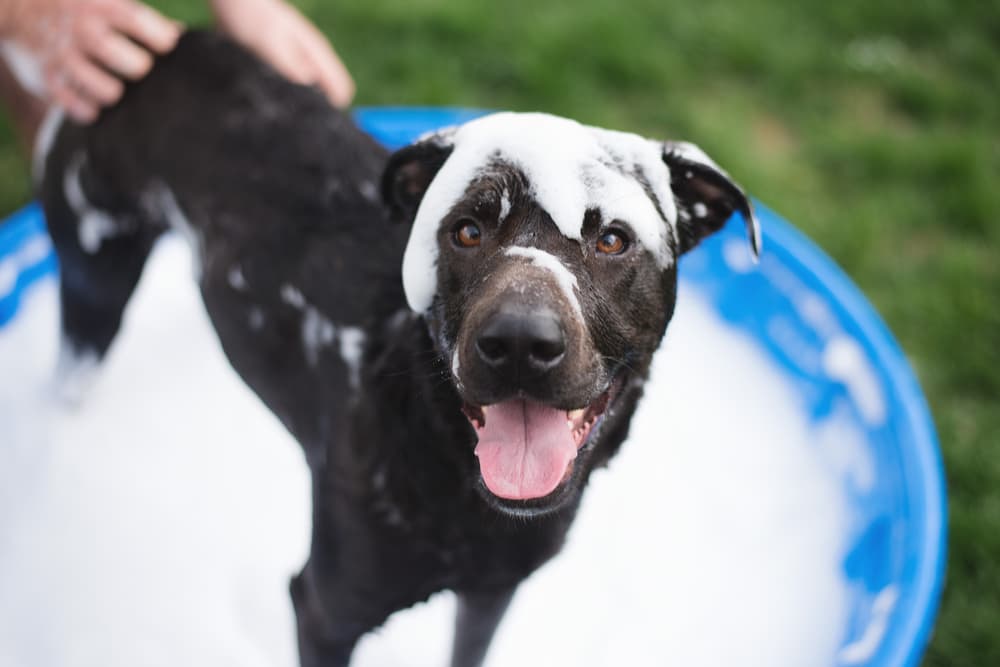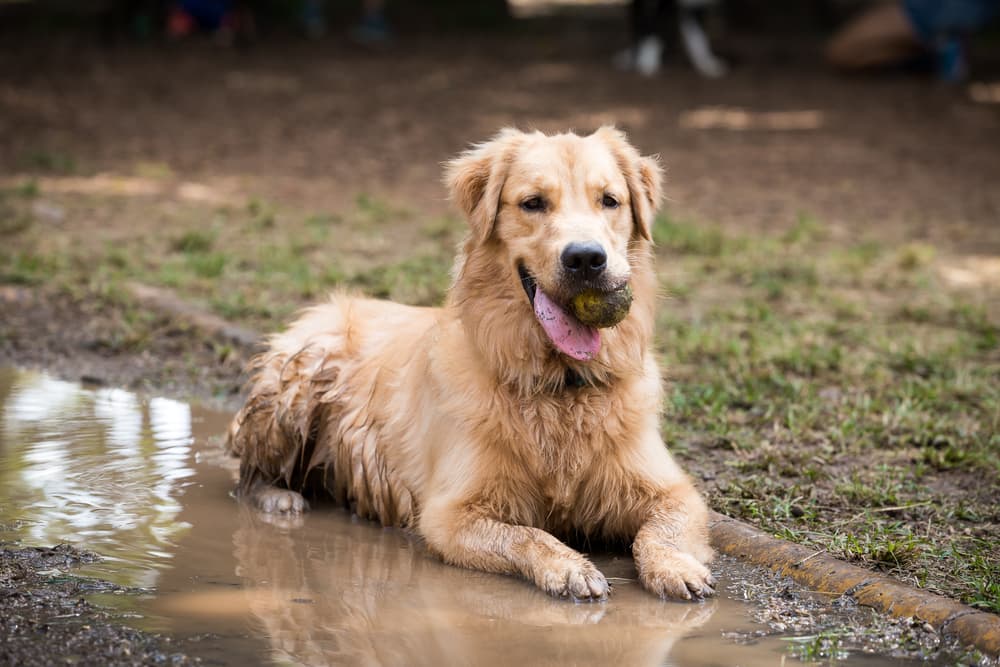How Often Should You Bathe Your Dog?

Does your dog hop into the bathtub, looking forward to the soothing, warm water and suds? Or does he run for the hills, fight you every step of the way, and create chaos in the house when he needs to be cleaned?
Regardless of whether your dog is a spa lover or a bathtime ball of nervous energy, the question may have popped into your head—how often do I actually need to do this?
If you’re wondering how often you should bathe your dog, there are a couple of variables to keep in mind. Let’s dive in and review the basics so you can come up with the right bathing balance for your pup.
How Often Should You Bathe a Dog?

The truth is, there is no set-in-stone answer to how often you should bathe your dog. It can depend on your dog’s skin and coat type, health issues, and the lifestyle your dog lives.
For an average dog—one that goes on leisurely walks, is generally healthy, and lives a normal life of lounging on the couch—he may not need to be bathed more than 3 to 4 times per year. Pet owners may choose to do this when their dog’s odor becomes noticeable.
Variables That Could Impact Bathing Frequency

There are instances where a dog needs to be bathed more or less than the average 3-4 times per year. Here are some other considerations when trying to determine if it’s time to bathe your pooch.
Your Dog’s Lifestyle
Is your dog the outdoorsy type? Does he enjoy swimming or frolicking in the woods? Does he enjoy long walks on the beach? Does he spend time romping through puddles and getting covered in mud? If so, you should play it by ear and bathe your dog as needed.
If dogs are avid swimmers, it’s important to clean off irritating salt or pool water from their skin and fur—even if it’s just a quick rinse. If your dog enjoys hiking and running amok in the muck, your pup may need a full bath to clean off dirt and debris.
Your Dog’s Overall Health
Does your dog suffer from an underlying disease? Certain medical conditions—such as hypothyroidism, Cushing’s disease, or diabetes—may cause secondary skin or coat issues. If your dog is ill in any way, speak with your veterinarian about the best bathing recommendations for your pet. A veterinarian may prescribe a special protocol or shampoo, as to not to dry out your dog’s skin or further exacerbate any issues.
Your Dog’s Skin/Coat Type
Does your dog have long, flowing hair? Or is he hairless? Different breeds have different coat types.
For instance, if you have a long-haired dog, such as a Collie or Sheltie, they need to be brushed before, during, and after their bath, and they also need a special doggie-conditioner to keep their fur from tangling and matting. A Chinese Crested has little to no hair, and may have blackheads that need a medicated shampoo to treat. If you have a double-coated dog, such as a Siberian Husky or Labrador Retriever, they may need a deshedding shampoo or no bath at all, just a good brushing. If a dog has a heavy coat, and is not thoroughly dried, they may get skin irritation, a rash, or infection from remaining moisture.
Consult your veterinarian or a groomer for instructions about bathing your specific dog breed.
Can You Bathe a Dog Too Often?

Yes, you can bathe a dog too often. Giving baths more than necessary may strip your dog’s coat of essential oils. This may cause secondary issues, such as a bacterial skin infection, or dry itchy skin. Frequent bathing could also complicate an underlying medical condition.
Speak to your veterinarian about what protocol works best for your dog’s specific needs before attempting any at-home grooming task.
When to Take Your Dog to a Professional Groomer

If at-home bathing sessions stress you out, a professional groomer can make sure your dog gets cleaned, brushed, and trimmed appropriately.
Groomers are educated, licensed, and experienced with all types of dog breeds, coat types, shampoos, conditioners, and other supplies. They may also pick up on underlying issues found during an appointment, such as skin irritation, tumors, cysts, an ear infection, or broken toenail.
If your dog’s fur is particularly matted or dirty, a groomer may have better tools and products to help remove mats and grime than you do at home.
If your dog suffers from any serious medical conditions, you can also ask your veterinarian if they provide grooming services at the clinic. Many veterinarians will offer grooming services for dogs with skin conditions or allergies.
A professional setting may also be more conducive to bathing your dog. If your home or apartment doesn’t have a bathtub or you don’t want your dog tracking water all over your house, taking your dog to a groomer may make your life easier.
Tips for Bathing Your Dog at Home

If you want to get down and dirty with giving your dog a bath at home, here are some tips to keep you and your spa buddy safe.
Have your supplies ready. Before you start bathing your dog, have all of your tools and supplies on hand. You may not be able to leave your dog in the tub while you run for a towel or cup. You may need towels, a cup for rinsing your dog, dog shampoo and conditioner, a blow dryer, cotton balls, and a brush and/or comb.
Brush your dog before bathing. Give your dog a thorough brush out, as this will help remove some of the loose fur, dirt, and debris, and save your drain.
Protect your dog’s ears and eyes. Place cotton balls in your dog’s ears to help keep any water and soap out. Be careful around your dog’s eyes and cover his eyes gently with your hand if you are rinsing his head. Some groomers recommend bathing your dog’s head last because getting their head wet can cause anxiety. Some dogs may benefit from simply wiping their head and face with a wet washcloth.
Use a shampoo formulated for dogs. Avoid using any human shampoos on dogs—even baby shampoo. Dogs and humans have different pH levels, so human shampoos can irritate a dog’s skin.
Follow instructions on the shampoo bottle. Follow the instructions on the shampoo bottle and be sure to rinse thoroughly. Any soap left behind can cause irritation to the skin, or your dog may ingest it by licking it off later.
Don’t let your dog drink bath water. Bath water shouldn’t be ingested. It can cause an upset stomach, vomiting, diarrhea, or lack of appetite.
Dry your dog thoroughly. Once you are finished, be sure to dry your dog using towels and/or a hairdryer. Some dogs may not like the dryer, so if your dog shows any signs of anxiety or discomfort, simply use a towel.
Watch for skin irritation. No matter what kind of shampoo you choose, keep an eye out for any adverse reactions. This may be red, irritated skin, itchiness, hair loss, or even hives. If you see any sign of a reaction, rinse your dog thoroughly and contact your veterinarian.









